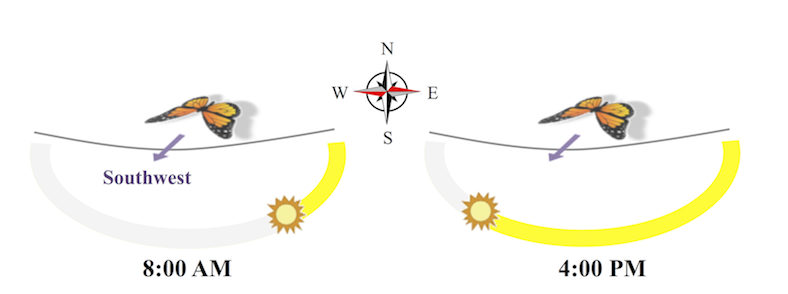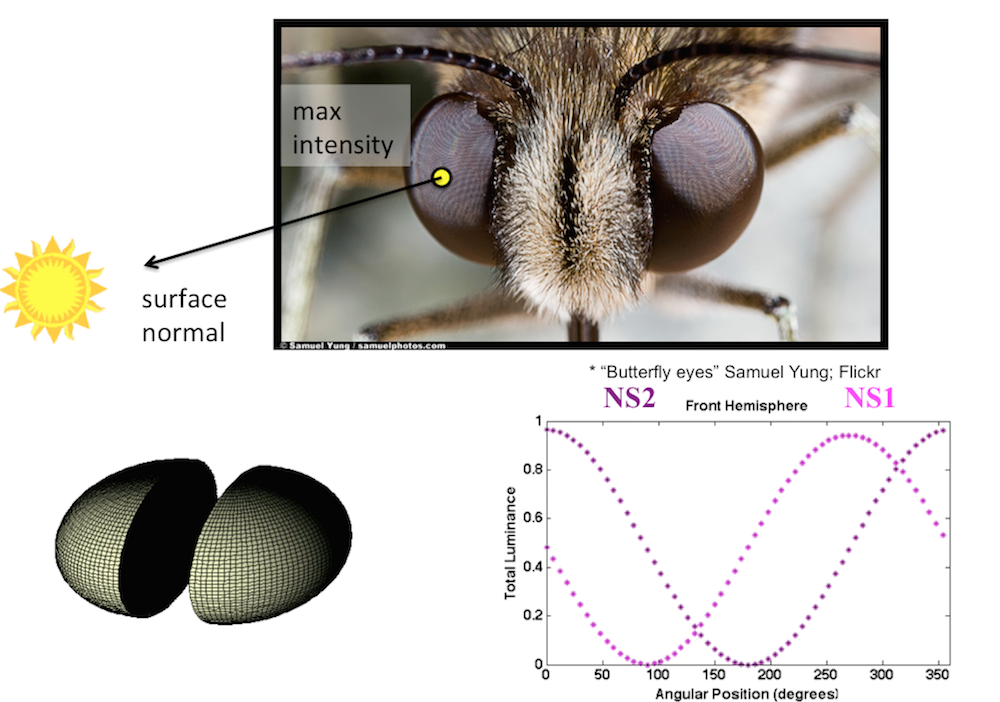Time-compensated sun compass in the migrating monarch butterfly
Cell Reports 2016
E. Shlizerman, J.Philips-Portillo, D. B. Forger, S. M. Reppert

Summary
Migrating Eastern North American monarch butterflies use a time-compensated sun compass to adjust their flight to the southwest direction. While the antennal genetic circadian clock and the azimuth of the sun are instrumental for proper function of the compass, it is unclear how these signals are represented on a neuronal level and how they are integrated to produce flight control. To address these questions, we constructed a receptive field model of the compound eye that encodes the solar azimuth. We then derived a neural circuit model, which integrates azimuthal and circadian signals to correct flight direction. The model demonstrates an integration mechanism, which produces robust trajectories reaching the southwest regardless of the time of day and includes a configuration for remigration. Comparison of model simulations with flight trajectories of butterflies in a flight simulator shows analogous behaviors and affirms the prediction that midday is the optimal time for migratory flight.Project Materials
Cell Reports 2016, Paper (Authors Version), Supplementary Material, Images, Youtube VideosPress
Newspapers and Online Media
UW news | Cell News | BBC News | BBC Science Video | Daily Mail | The Telegraph | CBC News | Mexico News Daily | Australia Network News | GizModo | China.org | National Post | Phys.Org | Value Walk | CSMonitor | Gazeta.ru | La Vanguardia | CDA News | The British Journal | WIRED.IT | Science News | Science 2.0 | Tech Times | Weekly Observer | Fox News | Technology | Nacional ...Results
Each fall hundreds of millions of monarch butterflies perform a spectacular journey from Northeast America to Central Mexico. To aid with navigation, monarchs are using a time-compensated sun compass to maintain southerly flight.|
Video from outdoors monarch flight experiment. Froy et al. 2003. Source: Reppert lab. |
Recorded flight direction reproduced from flight experiments performed in Guerra et al. 2012. |

Keeping Time
Monarchs have a circadian clock, housed in the antennae, capable to keep track of time-of-day and to control the sun compass timing. Previous work has shown that cells in the tissue of the antenna express transcriptional factors oscillating according to 24 hours rhythm and the antennae are critical for directional southerly flight.
Solar Azimuth Detection
Solar azimuth is detected by the monarch's eyes which are shaped as half spheres separated 180 deg from each other and composed of many individual lenses (ommatidia). While the exact mechanism for solar azimuth reception is unknown it is expected to be a robust and simple mechanism.
* Photo credit: Yung, Samuel http://samuelphotos.com
Integration Model
We then develop a neuronal circuit which integrates circadian and azimuthal signals to correct flight.
To test the time-compensated sun compass mechanism we computationally simulate the neuronal network. We also simulate the sun's position at different times of day and account for disturbances that could affect the detection of sun's position and incorporate disturbances that could displace the butterfly.
|
Simulated correction of flight direction at Midday time. |
Simulated correction of flight direction at Evening time. |
Taken together our results demonstrate a simple neuronal integration mechanism, based on matching spiking rates of clock and azimuth neural signals to provide angular position control. Such a mechanism is necessary for monarch butterflies to make this remarkable journey and reach their overwintering sites relying on limited food sources on their flight path.